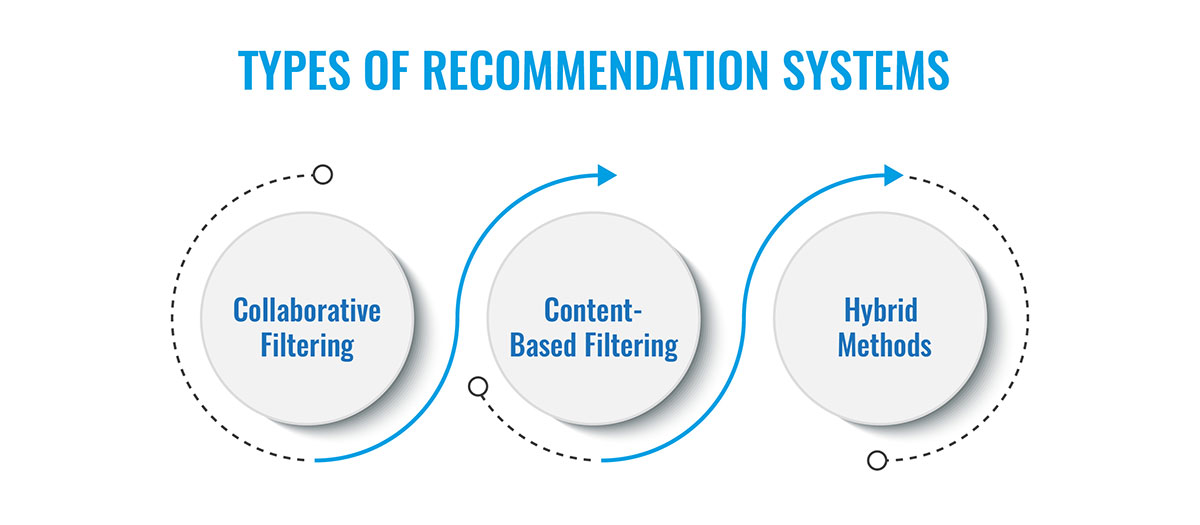
Recommendation systems are a critical component of solutions designed to support individual’s needs in the digital environment by suggesting pertinent information to them. Be it streaming services, or e-commerce platforms, these systems read user information to optimize content, thus making interaction more effective. This article takes the reader through the process of creating recommender systems in Python with a focus on the empirical application with examples. By leveraging powerful Python libraries, people can build complex recommendation systems that can address various needs, which demonstrates the synergy between Business Intelligence and Data Science.
Types of Recommendation Systems
Recommendation systems play a critical role in today’s applications utilizing big data solutions by applying algorithms as the best bet for recommending products or services that suit a particular user. There are primarily three types of recommendation systems:

1. Collaborative Filtering: This method suggests items based on the user’s activity and co-occurrence of users or items. It works because the same users that agreed earlier will agree in the future too. Collaborative filtering can be further categorized into:
- User-Based Collaborative Filtering: Computes user similarity by behavior or preference.
- Item-Based Collaborative Filtering: Provides recommendations depending on features and preferences from activities that a user is interested in.
2. Content-Based Filtering: This approach suggests that you recommend an item based on aspects concerning the item employing item attributes and users’ tendencies instead of the similarities of users. Content-based filtering involves:
- To develop recommendations, the features of items will be examined together with the profiles of the customers.
- Features such as Term Frequency-Inverse Document Frequency (TF-IDF) extract the features of the documents and compare the similarities.
3. Hybrid Methods: Hybrid recommendation systems take an integration of the collaborative and content-based filtering techniques for an improved method. These methods are also used to improve the various features of the recommended products, which are deemed to offer better and more diverse results by combining various approaches.
Knowledge of these types enables one to determine which one best suit the application given the data available, its intended use, and user preferences leading to efficient recommendation systems pertinent to a given context.
Data Collection and Preparation
The first essential step toward the development of an efficient recommendation mechanism is data acquisition and pre-processing. The most frequently recommended dataset for recommendation system projects is the MovieLens dataset— describing millions of movie ratings. This dataset is convenient to import in a Python environment by using pandas-related API. After loading the data, it also needs to be processed so that it contains no inaccurate or invalid data that will be difficult to sort through.
To begin, you should load the dataset into a pandas DataFrame:
CODE SNIPPET:
import pandas as pd
# Load the dataset
data = pd.read_csv('path_to_movielens_dataset.csv')
Next, perform data preprocessing to handle any missing values and normalize the data:
- Handling Missing Values: There must be a step taken to determine if any of the variables have missing values so that proper action can be taken on them. This could imply deleting entire rows with missing points or replacing them using the average or median of the particular parameters.
- Data Normalization: Some basic preprocessing steps would include the adjustment of ratings so that they lie within a fixed range, which is useful for enhancing the efficiency of recommendation system algorithms.
- Feature Engineering: Develop other aspects that may help in getting a more precise recommendation from the algorithm. This might include the users’ characteristics, movie categories, or other useful data.
- Splitting the Dataset: This makes it easier to determine the efficiency of the recommendation system by splitting the dataset into training and evaluating datasets. It can be an 80% /20% mix, where 80% is used to train the model and 20% to test it.
CODE SNIPPET:
# Handling missing values
data.dropna(inplace=True)
# Splitting the dataset
from sklearn.model_selection import train_test_split
train_data, test_data = train_test_split(data, test_size=0.2, random_state=42)
Thus, when your data is ready, you lay the good base for developing an efficient recommender system in Python. Data preparation prevents inaccuracies in the results, boosts the system’s stability, and provides a grounding for recommendations.
Building a Collaborative Filtering Recommendation System
One of the most commonly adopted techniques for the development of recommendation systems is collaborative filtering. It uses ratings and preferences of users to offer items that other like-minded consumers have recommended or given favorable ratings. There are two main types of collaborative filtering: it can be divided into two types which are user-based and item-based.
User-Based Collaborative Filtering
User-based collaborative filtering operates on the basis that if two users have similar leaning towards some items in the past, they will have the same thing towards other items in the future. The steps to implement this in Python are as follows:
1. Calculate User Similarity
While identifying the similarity between two users, we can use values envisaged using Pearson correlation or cosine similarity values. The similarity score represents how similar the two users’ preferences are.
CODE SNIPPET:
import pandas as pd
from sklearn.metrics.pairwise import cosine_similarity
# Load the dataset
ratings = pd.read_csv('ratings.csv')
# Create a pivot table
user_ratings = ratings.pivot_table(index='userId', columns='movieId', values='rating')
# Fill NaN with 0 (assumes unrated items as 0)
user_ratings = user_ratings.fillna(0)
# Calculate cosine similarity
user_similarity = cosine_similarity(user_ratings)
user_similarity_df = pd.DataFrame(user_similarity, index=user_ratings.index, columns=user_ratings.index)
2. Generate Recommendations
- For each user, identify the most similar users.
- Aggregate the ratings of theose users to generate a list of recommendations.
CODE SNIPPET:
def get_user_recommendations(user_id, user_ratings, user_similarity_df, num_recommendations=5):
_users = user_similarity_df[user_id].sort_values(ascending=False).index[1:]
similar_users_ratings = user_ratings.loc[similar_users]
user_recommendations = similar_users_ratings.mean(axis=0).sort_values(ascending=False)
# Filter out movies already rated by the user
already_rated = user_ratings.loc[user_id][user_ratings.loc[user_id] > 0].index
user_recommendations = user_recommendations.drop(already_rated, errors='ignore')
return user_recommendations.head(num_recommendations)
recommendations = get_user_recommendations(user_id=1, user_ratings=user_ratings,
user_similarity_df=user_similarity_df)
print(recommendations)
Item-based Collaborative Filtering
This is a system that aims at identifying the similarities between items offered to clients instead of trying to identify the common users. The rationale is that if a user has given positive feedback to some items, they will generally have a positive reaction to other goods in that category.
1. Calculate Item Similarity
Cosine similarity is one of the possible methods of determining the similarity between items. This goes a long way in finding out those items that are frequently similarly rated by users.
CODE SNIPPET:
# Transpose the user_ratings matrix
item_ratings = user_ratings.T
# Calculate cosine similarity between items
item_similarity = cosine_similarity(item_ratings)
item_similarity_df = pd.DataFrame(item_similarity, index=item_ratings.index,
columns=item_ratings.index)
2. Generate Recommendations
- For each item the user has rated, find the most similar items.
- Aggregate these similar items to generate a list of recommendations.
CODE SNIPPET:
def get_item_recommendations(user_id, user_ratings, item_similarity_df, num_recommendations=5):
user_rated_items = user_ratings.loc[user_id][user_ratings.loc[user_id] > 0].index
similar_items = pd.Series(dtype='float64')
for item in user_rated_items:
similar_items = similar_items.append(item_similarity_df[item].sort_values(ascending=False))
similar_items = similar_items.groupby(similar_items.index).mean().sort_values(ascending=False)
# Filter out items already rated by the user
similar_items = similar_items.drop(user_rated_items, errors='ignore')
return similar_items.head(num_recommendations)
item_recommendations = get_item_recommendations(user_id=1, user_ratings=user_ratings,
item_similarity_df=item_similarity_df)
print(item_recommendations)
Through user-based and item-based collaborative filtering, it can be possible to implement steady recommender systems using Python. While the former group is based on users’ similarity, the latter group is based on items’ similarity. Each of them has some benefits and can be applied depending on the task to be solved in the particular application. The given code samples give an initial point to develop and extend recommendation engine applications more appropriate for users and effective data processing through data analysis and data science tools.
Building a Content-Based Recommendation System
A Content-Based recommendation system recommends items similar to those that a user has expressed liking towards in the past based on the characteristics of the items. Unlike the previously described methods, this one uses the properties of items rather than their popularity among users.
Feature Extraction
- Identify Features: Identify important attributes by getting the features of the items. For instance, in a movie recommender system, some features could be the genres, directors, actors, and keywords.
- TF-IDF Vectorization: Apply Term Frequency-Inverse Document Frequency (TF-IDF) on the text data to transform the text data into numerical vectors. This technique is useful in assessing the relevance of a word in the given document in a comparative sense with other documents.
CODE SNIPPET:
import pandas as pd
from sklearn.feature_extraction.text import TfidfVectorizer
# Sample data
movies = pd.DataFrame({
'title': ['The Matrix', 'Inception', 'Interstellar'],
'description': [
'A computer hacker learns from mysterious rebels about the true nature of his reality and his role in the war against its controllers.',
'A thief who steals corporate secrets through the use of dream-sharing technology is given the inverse task of planting an idea into the mind of a CEO.',
'A team of explorers travel through a wormhole in space in an attempt to ensure humanity\'s survival.'
]
})
# TF-IDF Vectorization
tfidf = TfidfVectorizer(stop_words='english')
tfidf_matrix = tfidf.fit_transform(movies['description'])
Similarity Calculation
- Cosine Similarity: Calculate the cosine similarity between the vectors of items to find similar items.
- Example Code for Cosine Similarity
CODE SNIPPET:
from sklearn.metrics.pairwise import cosine_similarity
# Calculate the cosine similarity matrix
cosine_sim = cosine_similarity(tfidf_matrix, tfidf_matrix)
# Convert to DataFrame for better readability
cosine_sim_df = pd.DataFrame(cosine_sim, index=movies['title'], columns=movies['title'])
print(cosine_sim_df)
Generating Recommendations
- Find Similar Items: Use the similarity matrix to find items similar to a given item.
- Example Code for Recommendations:
def get_recommendations(title, cosine_sim=cosine_sim):
idx = movies.index[movies['title'] == title][0]
sim_scores = list(enumerate(cosine_sim[idx]))
sim_scores = sorted(sim_scores, key=lambda x: x[1], reverse=True)
sim_scores = sim_scores[1:4] # Top 3 recommendations
movie_indices = [i[0] for i in sim_scores]
return movies['title'].iloc[movie_indices]
# Example usage
print(get_recommendations('Inception'))
This is a content-based recommendation system, hence it does not rely on much user interaction data because it considers the features of the items. It is simple and effective in terms of content-based recommendation because it applies TF-IDF vectorization and cosine similarity to match the relevant items with users’ interests.
Evaluating the Recommendation System
It is extremely important to measure the performance of a recommendation system to assess its functionality and reliability. Based on the evaluation metrics, it is evident that recommender system performance can be described by several parameters. These metrics assist in finding out the percent with which the system has accuracy in making the prediction and coming up with better and more useful recommendations.
1. Root Mean Squared Error (RMSE):
This is defined as the arithmetic mean of the squares of the deviations between the forecasted and actual ratings and then taking the square root of the result. Lower values of RMSE would imply better performance.
CODE SNIPPET:
from sklearn.metrics import mean_squared_error
import numpy as np
rmse = np.sqrt(mean_squared_error(y_true, y_pred))
print(f'RMSE: {rmse}')
2. Mean Absolute Error (MAE):
This metric quantifies the average of the difference taken between the predicted and actual ratings. It offers a clear-cut insight into the accuracy of the prediction models.
CODE SNIPPET:
from sklearn.metrics import mean_absolute_error
mae = mean_absolute_error(y_true, y_pred)
print(f'MAE: {mae}')
3. Precision and Recall:
These metrics are very helpful in the analysis to determine the usefulness of recommendations. Precision is defined by the number of recommended items that are considered relevant, whereas recall is the number of relevant items that are recommended.
CODE SNIPPET:
from sklearn.metrics import precision_score, recall_score
precision = precision_score(y_true_binary, y_pred_binary)
recall = recall_score(y_true_binary, y_pred_binary)
print(f'Precision: {precision}, Recall: {recall}')
Such metrics help to assess the system and get an overall idea of its performance, which would make it easier for data scientists to detect some issues that need to be optimized. Thus, working with the recommender systems in Python always requires constant updating and testing to ensure their high accuracy and applicability.
Improving the Recommendation System
Enhancement techniques for recommendation systems consist of techniques. This includes matrix factorization, where deep learning models can be used to extract features from the original recommendation matrix, and ensemble techniques aimed at boosting the accuracy of the prediction models. This process is accompanied by hyperparameter optimization of models and the inclusion of the feedback loop to incorporate the users’ feedback into the ongoing recommendations. One could also continue to use a combination of features and techniques from the collaborative and content filtering categories to improve the system’s efficiency. Using reliable measures helps configure the effectiveness of improvements, thus maintaining a changing system that can address the changes in user demands and dataset properties.
Conclusion
With Python, the development of recommendation systems can enhance user experiences across different platforms. Using the recommender systems in Python, developers can design resilient algorithms through the application of collaborative and content-based filtering. A consistent system of evaluating recommendations enables the accuracy and relevance of the recommendations. In the future, expanding the use of hybrid methods and data-gathering approaches can improve the system's efficiency. Encouraging changes and adaptations for implementation depending upon the users’ requirements, these ideas reaffirm the importance of recommender systems in increasing user satisfaction as well as engagement in the contemporary digital environment.


































